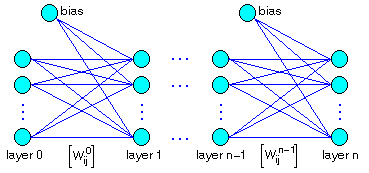Multi-Layer Perceptron
{0;1} |
Introduction
A multi-layer perceptron is made up of several layers of neurons. Each
layer is fully connected to the next one. Moreover, each neuron receives
an additional bias input as shown in figure 1:
Ip  Ap
Figure 1: a fully interconnected, biased, n-layered back-propagation
network
Ap
Figure 1: a fully interconnected, biased, n-layered back-propagation
network
-
Wijk = weight from unit i (in layer v) to unit j
(in layer v+1).
-
Ip = input vector (pattern p) = (I1p,
I2p, ..., Ibp).
-
Ap = Actual output vector (pattern p) = (A1p,
A2p, ..., Acp).
In this applet, the ouput values of the neurons stand in {0;1}.
Credits
The original applet was written by Olivier
Michel.
Instructions
To change the structure of the multi-layer perceptron:
- change the values H1, H2 and H3 corresponding to the number of units in
the first second and third hidden layer. If H3 is equal to 0, then only
two hidden layers are created ; if both H3 and H2 are equal to 0 a single
hidden layer is created and if all H1, H2 and H3 are null, no hidden layer
is created, corresponding to a single layer perceptron.
-
click on the Init button to build the requested structure and initialize
the weights.
Applet
Questions
-
Try to characterize the problems the simplest multi-layer perceptron is
able to solve. Reminder: the simplest multi-layer perceptron would
be a multi-layer perceptron with a single hidden layer containing a single
unit. Is it able to solve classification problems which are not linearly
separable?
-
Set three clusters of points in a line: a red one with 3 points, a blue
one with 6 points, then a red one with three points. Does the simplest
multi-layer perceptron solve this problem ? If not, what is the minimuls
structure necessary to solve the problem? With which momentum and learning
rate ?
-
Set a cluster of red points (1.0) in the center, surrounded by blue points.
Which network structure and which momentum / learning rate combination
can solve such a problem?
 Ap
Ap